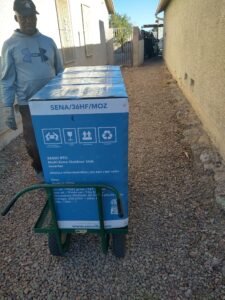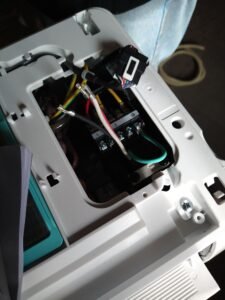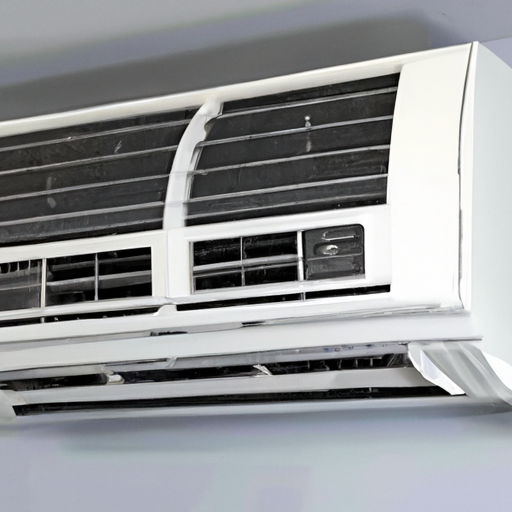Retrofitting an existing central air conditioning system with a ductless mini-split system is a question that many homeowners and building owners are asking. Mini split heating and cooling systems have become a popular choice for their energy efficiency, ease of installation, and flexibility. This article will explore the feasibility of retrofitting an existing central air conditioning system with a ductless mini-split system, considering factors such as compatibility, installation requirements, and cost-effectiveness. It aims to provide readers with the necessary information to make an informed decision about upgrading their HVAC system.

Overview of Retrofitting an Existing Central Air Conditioning System
What is retrofitting?
Retrofitting refers to the process of upgrading or modifying an existing system or structure to improve its performance, functionality, or energy efficiency. In the context of central air conditioning systems, retrofitting involves replacing or augmenting the existing system with a ductless mini-split system to enhance cooling and heating capabilities.
What is a ductless mini-split system?
A ductless mini-split system, also known as a mini split or ductless heat pump, is a type of HVAC system that consists of an outdoor unit and one or more indoor units. Unlike traditional central air conditioning systems that rely on ductwork to distribute conditioned air, mini-split systems deliver cool or warm air directly to individual zones or rooms. These systems use refrigerant lines to connect the outdoor and indoor units, providing efficient and targeted heating and cooling.
Benefits of retrofitting with a ductless mini-split system
There are several advantages to retrofitting an existing central air conditioning system with a ductless mini-split system:
- Zoning capabilities: Ductless mini-splits allow for individual temperature control in different zones or rooms, improving comfort and energy efficiency.
- Better indoor air quality: Since mini-split systems do not rely on ductwork, there is no potential for dust, allergens, or contaminants to accumulate and circulate throughout the system.
- Simplified maintenance and repairs: With fewer components and no ductwork to maintain, cleaning and servicing a ductless system is typically easier and more straightforward.
- Flexibility in heating and cooling individual zones: Ductless mini-splits can be installed in specific areas of the house, enabling efficient cooling or heating of occupied spaces without conditioning the entire home.
- Energy efficiency and potential cost savings: By delivering conditioned air directly to the desired areas, ductless mini-splits eliminate the energy losses associated with ductwork, resulting in potential energy savings and reduced utility bills.
Considerations before Retrofitting
Assessing the existing central air conditioning system
Before considering retrofitting with a ductless mini-split system, it is crucial to assess the condition and performance of the existing central air conditioning system. An evaluation by a professional HVAC technician can identify any underlying issues, such as duct leaks, inadequate insulation, or outdated components, which may affect the retrofitting process or the overall effectiveness of the new system.
Determining compatibility with a ductless mini-split system
Not all existing central air conditioning systems can be retrofitted with a ductless mini-split. Compatibility must be determined based on factors such as the age and type of the existing system, available power supply, and structural considerations. A professional HVAC technician can evaluate these aspects and provide expert advice on whether retrofitting is feasible and recommend suitable mini-split options.
Calculating cooling and heating demands
To ensure effective cooling and heating, it is essential to calculate the cooling and heating demands of the specific zones or rooms that the mini-split system will serve. Factors such as room size, insulation, sun exposure, and occupancy level should be taken into account. This information will help determine the appropriate capacity and configuration of the mini-split system, ensuring optimal performance and energy efficiency.
Considering the layout and space for indoor and outdoor units
The layout of the building and available space for the indoor and outdoor units is a crucial consideration when retrofitting with a ductless mini-split system. Indoor units are typically mounted on walls, in ceilings, or as freestanding units, while the outdoor unit requires sufficient space for proper airflow and accessibility. Assessing the space requirements and ensuring adequate placement options are available is necessary to avoid obstruction or inefficient operation of the system.
Steps to Retrofitting with a Ductless Mini-split System
Hiring a professional HVAC technician
To ensure a successful retrofitting process, it is recommended to hire a professional HVAC technician who specializes in ductless mini-split installations. A qualified technician can assess the specific needs of the building, provide expert advice on system selection, and perform the installation to industry standards.
Removing existing ductwork and components
As part of the retrofitting process, the existing ductwork and other components of the central air conditioning system need to be removed. This ensures a clean slate for the installation of the ductless mini-split system. Removing the old ductwork may also uncover any existing issues or areas for improvement in the building’s HVAC infrastructure.
Electrical modifications and installation
Electrical modifications may be required to accommodate the power demands of the new mini-split system. It is crucial to ensure that the existing electrical system is capable of supporting the additional load. A licensed electrician should perform any necessary modifications and ensure compliance with electrical codes and safety regulations.
Mounting the indoor and outdoor units
The indoor units of the ductless mini-split system should be strategically placed in each zone or room to provide optimal coverage and airflow. It is important to consider factors such as height, accessibility, and aesthetic impact. The outdoor unit needs to be mounted in a suitable location, preferably with sufficient clearance for airflow and ease of maintenance.
Connecting the refrigerant lines
Refrigerant lines are used to connect the outdoor and indoor units in a ductless mini-split system. These lines should be carefully sized, insulated, and installed to ensure efficient refrigerant flow and prevent any leaks. Proper installation and insulation of the refrigerant lines are critical for the system‘s performance and longevity.
Installation of the thermostat and controls
A thermostat or control system is essential for monitoring and adjusting the temperature settings of the ductless mini-split system. The installation of the thermostat and controls should be done according to manufacturer instructions and in a convenient location for easy access and operation. It is important to program the thermostat correctly to optimize energy savings and comfort.
Potential Challenges and Solutions
Structural modifications
In some cases, retrofitting with a ductless mini-split system may require structural modifications to accommodate the indoor and outdoor units. This can include installing mounting brackets, reinforcing walls, or running conduits for electrical and refrigerant lines. Consulting with a contractor or engineer can help determine the feasibility of these modifications and ensure compliance with building codes.
Upgrading electrical capacity
Depending on the power requirements of the ductless mini-split system, upgrading the electrical capacity of the building may be necessary. This may involve installing a new electrical circuit, upgrading the electrical panel, or increasing the service capacity. A licensed electrician should assess the electrical system and perform any required upgrades to ensure safe and reliable operation.
Space limitations for installation
Limited space may pose a challenge when retrofitting with a ductless mini-split system. In situations where there is insufficient room for indoor or outdoor units, alternative installation options may need to be explored. This could involve using compact or ceiling-mounted units, considering multiple smaller units instead of a single large one, or reconfiguring the layout to accommodate the system.
Addressing compatibility issues
Compatibility issues may arise when retrofitting an existing central air conditioning system with a ductless mini-split system. This could be due to differences in refrigerant types, electrical requirements, or functionality. A professional HVAC technician can identify these compatibility issues and recommend appropriate solutions, such as retrofitting adapters, upgrading components, or selecting a compatible mini-split system.
Dealing with outdated or incompatible thermostats
If the existing central air conditioning system uses an outdated or incompatible thermostat, it may need to be replaced during the retrofitting process. Upgrading to a thermostat that is compatible with the ductless mini-split system will ensure proper control and functionality. It is advisable to consult with a professional technician to determine the most suitable thermostat for the specific mini-split system being installed.
Handling refrigerant and refrigerant lines
Proper handling and installation of refrigerant lines are critical for the optimal performance and longevity of a ductless mini-split system. It is essential to ensure that the refrigerant lines are correctly routed, sized, and insulated to prevent any refrigerant leakage or heat loss. Only licensed HVAC technicians should handle refrigerant and perform the installation to ensure compliance with safety and environmental standards.

Cost Considerations
Cost comparison between retrofitting and replacing
When considering retrofitting an existing central air conditioning system with a ductless mini-split, it is important to compare the costs of retrofitting versus completely replacing the entire system. While retrofitting may be a more cost-effective solution in certain scenarios, there are cases where replacing the existing system with a new one may offer better long-term benefits and savings. A professional assessment can help determine the most cost-effective option based on the specific circumstances.
Factors influencing the cost of retrofitting
The cost of retrofitting with a ductless mini-split system can vary depending on several factors, including the size of the building, the number of zones or rooms to be heated or cooled, the complexity of the installation, and any necessary structural modifications or electrical upgrades. Obtaining multiple quotes from reputable HVAC professionals is recommended to understand the estimated costs and make an informed decision.
Potential energy savings and long-term cost benefits
While retrofitting with a ductless mini-split system may involve an upfront investment, it is essential to consider the potential energy savings and long-term cost benefits. Ductless mini-splits are known for their energy efficiency and targeted heating and cooling capabilities, which can lead to reduced energy consumption and lower utility bills over time. It is advisable to compare the estimated energy savings with the initial investment to assess the payback period and overall cost-effectiveness of the retrofitting project.
Factors to Determine the Feasibility of Retrofitting
Age and condition of the existing central air conditioning system
The age and condition of the existing central air conditioning system can significantly impact the feasibility of retrofitting. Systems that are old, inefficient, or nearing the end of their lifespan may be better candidates for complete replacement rather than retrofitting. Assessing the overall condition and performance of the existing system is crucial in determining the most appropriate course of action.
Energy efficiency of the existing system
Another important factor to consider is the energy efficiency of the existing central air conditioning system. If the system is already energy-efficient and performs well, retrofitting may not provide significant additional benefits. On the other hand, if the system is outdated or inefficient, retrofitting with a ductless mini-split can improve energy efficiency and reduce environmental impact.
Availability of space for indoor and outdoor units
The available space for installing the indoor and outdoor units is a key consideration for retrofitting with a ductless mini-split system. If there is limited or inadequate space, alternative solutions or system configurations may need to be explored. It is crucial to evaluate the physical constraints of the building and ensure that the necessary space is available for proper installation and operation of the mini-split system.
Budget constraints
Budget constraints are an important factor when considering retrofitting with a ductless mini-split system. While the initial cost of retrofitting may be higher compared to traditional central air conditioning systems, it is important to evaluate the long-term cost benefits and potential energy savings. Understanding the upfront investment and projected payback period can help make an informed decision based on the available budget.
Personal preferences and comfort requirements
Personal preferences and comfort requirements should also be taken into account when contemplating retrofitting with a ductless mini-split system. Some individuals may prefer the ability to control temperatures in individual zones or rooms, while others may prioritize aesthetics or simplicity. It is important to align the comfort requirements and preferences with the features and capabilities of a ductless mini-split system to ensure satisfaction with the retrofitting results.

Advantages of Retrofitting with a Ductless Mini-split System
Zoning capabilities for efficient temperature control
One of the primary advantages of retrofitting with a ductless mini-split system is the ability to achieve efficient temperature control in specific zones or rooms. By delivering conditioned air directly to the desired areas, mini-splits allow for individualized temperature settings and avoid wasting energy on unoccupied spaces. This zoning capability can result in increased comfort and reduced energy consumption.
Better indoor air quality
Since ductless mini-split systems do not rely on ductwork, there is no potential for dust, allergens, or contaminants to accumulate and circulate throughout the system. This can lead to improved indoor air quality, especially for individuals with allergies or respiratory conditions. The absence of ductwork also reduces the risk of duct leaks, which can contribute to mold growth and indoor air pollution.
Simplified maintenance and repairs
With fewer components and no ductwork to maintain, ductless mini-split systems generally require less maintenance compared to traditional central air conditioning systems. Cleaning the filters and checking the outdoor unit regularly are typically the main maintenance tasks. Additionally, if repairs are needed, troubleshooting and accessing the components are often easier and less time-consuming.
Flexibility in heating and cooling individual zones
Retrofitting with a ductless mini-split system provides the flexibility to heat or cool individual zones or rooms based on occupancy and comfort requirements. This allows for customized temperature control and avoids wasting energy on unoccupied areas. For multi-story buildings or houses with different temperature preferences in different areas, a ductless mini-split system can provide tailored heating and cooling solutions.
Energy efficiency and potential cost savings
Ductless mini-split systems are known for their energy efficiency, primarily due to the absence of ductwork, which can result in significant energy losses. By eliminating these losses and allowing for targeted temperature control, ductless mini-splits can reduce energy consumption and potentially lower utility bills. The initial investment in retrofitting with a ductless mini-split system can be offset by long-term energy savings and increased efficiency.
Disadvantages and Limitations
Higher upfront cost compared to traditional central air conditioning systems
One of the main disadvantages of retrofitting with a ductless mini-split system is the higher upfront cost compared to traditional central air conditioning systems. The cost of the indoor and outdoor units, as well as the installation and potential modifications, can be a significant investment. However, it is important to consider the long-term energy savings and potential cost benefits when evaluating the overall value of the retrofitting project.
Limited range of cooling and heating capacity
Ductless mini-split systems are designed to provide heating and cooling for specific areas or zones, which may limit their overall cooling or heating capacity compared to traditional central air conditioning systems. It is important to properly size and configure the system based on the specific needs of the building to ensure adequate comfort and temperature control. In some cases, additional indoor units or alternative heating solutions may be necessary to meet the demands of larger spaces or buildings.
Aesthetics and potential impact on interior design
While ductless mini-split systems offer flexibility in terms of installation and unit placement, the presence of the indoor units may impact the aesthetics and interior design of the space. The units can be mounted on walls, installed in ceilings, or placed as freestanding units, but they still require careful consideration to ensure they blend well with the existing decor. For individuals who prioritize interior design, the visual impact of the units should be taken into account when deciding on retrofitting with a ductless mini-split system.

Expert Recommendations
Consultation with a professional HVAC technician
Before proceeding with retrofitting an existing central air conditioning system with a ductless mini-split system, it is highly recommended to consult with a professional HVAC technician. An experienced technician can assess the specific requirements of the building, evaluate compatibility and feasibility, and provide expert advice on system selection, installation, and potential challenges. Their expertise can ensure a successful retrofitting process and optimal performance of the mini-split system.
Evaluating the overall cost-benefit ratio
When considering retrofitting with a ductless mini-split system, it is important to evaluate the overall cost-benefit ratio. This includes comparing the initial investment and potential energy savings over time, as well as the anticipated comfort and convenience benefits. By weighing the costs against the expected benefits, individuals can make an informed decision based on their specific circumstances and priorities.
Considering long-term energy savings and environmental impact
Retrofitting with a ductless mini-split system can offer significant long-term energy savings and reduce the environmental impact associated with energy consumption. By focusing on targeted temperature control and eliminating energy losses through ductwork, mini-split systems can be more energy-efficient compared to traditional central air conditioning systems. When making the decision to retrofit, considering the long-term energy savings and environmental benefits can provide added value to the retrofitting project.
Exploring available rebates and incentives
To further support the decision to retrofit with a ductless mini-split system, individuals should explore the availability of rebates, incentives, or tax credits offered by local or federal authorities, utility companies, or other organizations. These financial incentives can help reduce the upfront cost of retrofitting and improve the overall cost-effectiveness of the project. It is advisable to consult with a professional HVAC technician or research available programs to take advantage of any incentives.
Conclusion
Retrofitting an existing central air conditioning system with a ductless mini-split system can provide numerous benefits, including enhanced temperature control, improved indoor air quality, simplified maintenance, and potential energy savings. However, careful considerations and assessments are necessary to determine the feasibility and compatibility of retrofitting for each specific situation. Consulting with a professional HVAC technician and evaluating factors such as the age and condition of the existing system, space availability, and personal preferences can help make an informed decision on whether retrofitting is the right choice. By weighing the advantages, limitations, cost considerations, and expert recommendations, individuals can determine the most suitable course of action for their cooling and heating needs.

